Below is a map of all of our stops we made along the way this year.
(The blue marks for the stops may not show up in Internet Explorer, try another browser like Firefox or Chrome)
View 2011 Alaska Cruise in a larger map
Below is a map of all of our stops we made along the way this year.
(The blue marks for the stops may not show up in Internet Explorer, try another browser like Firefox or Chrome)
To close out our 2011 cruise on the morning of September 17 we headed south down Rosario Strait, along the west shore of Whidbey Island and into Admiralty Inlet. There is lots of commercial traffic in that area, so you venture into the vessel traffic lanes with a keen eye on the AIS in order to make sure you aren’t going to run over by a freighter moving at 20 knots. We will able to successfully cross without any major issue.
On account of the timing of the currents and the shorter days, we knew we needed an intermediate stop for the night between Anacortes and Winslow (Bainbridge Island). We decided to try the inner harbor in Port Ludlow. While the entrance is a bit shallow (~15 feet), it was short and straight with no current. Additionally, it was very protected from winds, a important consideration given the forecasted high winds for the next day. To top it off, the anchorage was remarkably scenic. While there were many homes along the shore, they were landscaped nicely and not closely packed.
The next morning, September 18, we elected to take a rest day and not move. The weather wasn’t terrible but docking with significant winds (15-25 kts) is not my favorite thing. The winds the next day were forecasted as light.
The early start on September 19 put us at the Queen City Yacht Club docks in Winslow before noon. We used the afternoon to start the boat cleaning process. Marcia working the interior while I tackled the exterior.
On September 20, the weather remained lovely for the final miles across Puget Sound, through the Ballard Locks and along the Lake Washington Ship Canal to our winter moorage in Lake Union. When transiting the locks we do our best to select a less busy day and time and calm winds. With just the two of us on board, we want to stack the odds in favor of an uneventful “lock-thru” and everything went smoothly. The time from Winslow to Lake Union, three draw bridges that had to open and one lock-thru was less than three hours.
The distance on this leg was 85.7 miles bringing the total trip distance to 3465.3 nautical miles. Total engine hours were 577.4 which works out to 6 miles per hour of engine time. Our actual speed is a bit faster since the engine hours include the time from when we weigh anchor or unmoor at the beginning of the day to the time when we are secured at anchor or dock at the end.
The winds that blew us onto the dock in Ganges quieted down overnight and our departure on the morning of September 13 was very uneventful. We motored down Saanich Inlet and entered the calm protected waters of Tod Inlet.

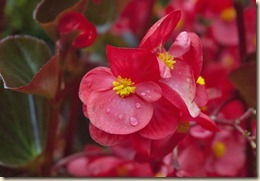 impressive.
impressive.
As we paddled back to the boat from shore, another kayak was paddling along the shore. As he got closer, he asked whether I was “Kurt Hanson.” I was a bit taken back but he introduced himself as Brian McCutcheon a friend of John Douglas owner of Laysan, a sister ship to ours. John is preparing to bring his boat back from Subic Bay in the Philippines to Hawaii where John lives. He asked Brian to intercept us in Tod Inlet and find out how things have been working in the long term on our boat.
It was a great visit and we wish John a safe and speedy journey across the Pacific.
The next morning, September 14, we headed across Haro Strait and reentered US waters. We’ve signed up through the NEXUS program with the Customs and Border Patrol and were able to clear over the telephone. We proceeded directly to Echo Bay on Sucia Island where we dropped the anchor.
The entire island is a Washington State Park and it has some very pleasant trails to walk. We elected to spend two nights so that we could cover them all.
An early start the morning of September 16 got us to the fuel dock in Anacortes at 10:30 AM. The only fuel we had taken on since last September was 200 gallons in Juneau. We weren’t surprised it took 1090 gallons to fill all our tanks. The 1290 gallons since last year has cover 580 engine hours, 30 genset hours and lots of furnace operation. We were in our assigned slip in Cap Sante Marina by noon.
From here we will head south to Seattle. We will probably swing by our yacht club’s (Queen City YC) outstation in Winslow for a night or two prior to transiting the locks into Lake Union. Hopefully home next Tuesday, 9/20.
Distance covered this leg is 83.3 for a total of 3379.6 nautical miles.
Boy, a little blue sky, warm sun and calm winds can really improve a cruiser’s disposition. This leg has had some of the most relaxing cruising we’ve ever done.
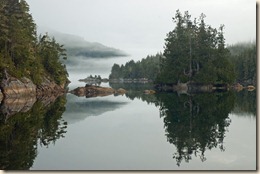 When we left Pierre’s at Echo Bay on September 4, we weren’t done with the Broughtons. We decided to put in two grueling 8 mile days and visit anchorages we’ve not used before. The first was Sea Breeze Cove. It is tucked in amongst some islands which offered some fun exploring opportunities in our kayaks.
When we left Pierre’s at Echo Bay on September 4, we weren’t done with the Broughtons. We decided to put in two grueling 8 mile days and visit anchorages we’ve not used before. The first was Sea Breeze Cove. It is tucked in amongst some islands which offered some fun exploring opportunities in our kayaks.
The next day’s anchorage, Mound Island, was not as intimate but it too offered some kayaking opportunities and an island on which to explore.
On September 6 we positioned ourselves to transit the narrows that divide the waters of the northern section of the inside passage from the southern. A number of boats had similar ideas so there were a half dozen other boats in Port Neville that night. It is a large anchorage so no one should have felt crowded.
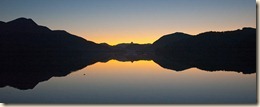 The sunrise on September 7, was spectacular and we made good time down Johnstone Strait riding the flood south. Rather than use Seymour Narrows as we did on the way north, we took Okisollo Channel and spent the night in Octopus Island Marine Park. We did this same path last year on the southbound leg of our trip.
The sunrise on September 7, was spectacular and we made good time down Johnstone Strait riding the flood south. Rather than use Seymour Narrows as we did on the way north, we took Okisollo Channel and spent the night in Octopus Island Marine Park. We did this same path last year on the southbound leg of our trip.
An early start the morning of September 8, got us through Hole-in-the-Wall Rapids on the slack before the flood. By lunch we were anchored in Prideaux Haven in Desolation Sound.
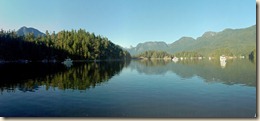 Some might consider the area’s name to be an oxymoron since in the main cruising season it is anything but desolate but when the temperatures are in the upper 70’s, the sun is shining and the wind isn’t blowing, we become very tolerant of the 20+ boats with whom we are sharing the anchorage. The conditions on this visit were very similar to our first trip to Desolation Sound in our two person kayak during September nearly 20 years ago.
Some might consider the area’s name to be an oxymoron since in the main cruising season it is anything but desolate but when the temperatures are in the upper 70’s, the sun is shining and the wind isn’t blowing, we become very tolerant of the 20+ boats with whom we are sharing the anchorage. The conditions on this visit were very similar to our first trip to Desolation Sound in our two person kayak during September nearly 20 years ago.
Since the weather was so nice, we decided to spend two nights at anchor in Prideaux Haven.
On September 10, we started the trip down the Straits of Georgia (part of the Salish Sea) and anchored in Ballet Bay. Our last visit here was in 2007 during a 7-week trip on our first boat. There has been quite a bit of development on the land surrounding this protected anchorage since then.
In the morning of September 11, we crossed the Straits of Georgia from the mainland side to the Vancouver Island side. We experienced the joys of the strong westerly winds that funnel across the Qualicum gap of Vancouver Island and hit you broad side as you angle across the strait. We took a 3-hour lunch break in Silva Bay while waiting for the current in Gabriola Pass to slacken.
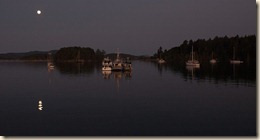 After restarting, we anchored for the evening in Clam Bay on Thetis Island. Many other boaters were enjoying some of the last summer weather in Clam Bay. The nearly full moon put on a stunning show for the nearly 20+ other boaters in the anchorage.
After restarting, we anchored for the evening in Clam Bay on Thetis Island. Many other boaters were enjoying some of the last summer weather in Clam Bay. The nearly full moon put on a stunning show for the nearly 20+ other boaters in the anchorage.
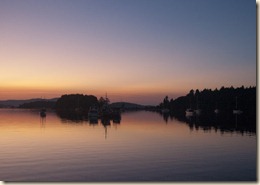 Twelve hours later, on the morning of September 12, those same boaters were greeted by a sunrise to rival the moon’s efforts.
Twelve hours later, on the morning of September 12, those same boaters were greeted by a sunrise to rival the moon’s efforts.
We left Clam Bay and traveled the relatively short distance to Salt Spring Marina to catch on the basics (laundry, wine and produce). From here the plan is to spend a night or two at Tod Inlet near the Butchart Gardens and then to cross back into the San Juans.
Distance covered this leg was 239.9 raising the total to 3296.3 nautical miles.
The Broughtons are a popular cruising area east of Port McNeill at the junction of Johnstone Strait and Queen Charlotte Strait. It has many protected channels, bays, coves and small marinas. On account of it being north of Seymour Narrows and its cousins (e.g., Yuculta, Dent, Surge) getting here takes a bit of effort so it is less crowded than Desolation Sound or the Canadian Gulf Islands.
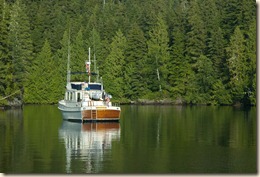 We left Port McNeill on September 1 and traveled to Laura Cove. The descriptions of the anchorage in the guides are glowing and describe it well. Its only drawback for us was the very hard bottom which made hooking the anchor difficult. Fortunately the winds were light so we never tested it.
We left Port McNeill on September 1 and traveled to Laura Cove. The descriptions of the anchorage in the guides are glowing and describe it well. Its only drawback for us was the very hard bottom which made hooking the anchor difficult. Fortunately the winds were light so we never tested it.
Before we left Port McNeill, Marcia made reservations for moorage and attendance at the very popular pig roast at the Pierre’s in Echo Bay. It was only a short distance from our anchorage so when we left the next morning, September 2, we took a sightseeing detour into Simoom Sound to check out other anchorages in the area before tying up here.
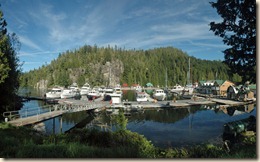 There are about a half-dozen small marinas that operate in the Broughtons. They cater to cruisers and sport fisherman visiting the area during the short summer season. They operate off the grid but usually provide all of the services that folks are looking for. At Pierre’s, the Saturday pig roasts have helped it attract cruisers.
There are about a half-dozen small marinas that operate in the Broughtons. They cater to cruisers and sport fisherman visiting the area during the short summer season. They operate off the grid but usually provide all of the services that folks are looking for. At Pierre’s, the Saturday pig roasts have helped it attract cruisers.
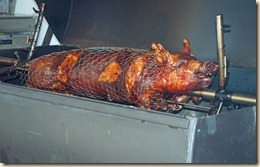 The event is very social and the conviviality was aided but the sunny and warm (by coastal standards) temperature. People compare notes on destinations and talk boats. There is ample food (potluck side dishes) and ample pork.
The event is very social and the conviviality was aided but the sunny and warm (by coastal standards) temperature. People compare notes on destinations and talk boats. There is ample food (potluck side dishes) and ample pork.
From here we’ll continue the slow southbound journey, stopping in Desolation Sound for a day or two. The next likely marina stop will be somewhere in the Canadian Gulf Islands.
Distance covered this leg was 47.5 nautical miles (told you we’d slow down) bringing the total to 3056.4.
It seemed as though we’ve repeated the frenetic pace of the northbound trip in our southbound journey. We are now docked in Port McNeill after covering the 295 miles from Prince Rupert in four days. The last three days were all nearly 12 hours underway. On account of the shorter days, we started all of of our days before sunrise.
On last year’s southbound trip, because of the time of the month, we frequently encountered opposing currents. This year, we were luckier and did a better job of choosing anchorages so that we could frequently ride favorable currents for much of the day.
On August 27, we revisited Lowe Inlet, an anchorage we used on the northbound trip. We were surprised that no one else anchored here as it is a convenient distance from Prince Rupert and quite lovely.
The next day, August 28, we continued the trip down Grenville and Princes Royal Channels (the “ditch”) and anchored in Mary Cove. This was a new anchorage to us and one we would use again as it is just a short distance off the main channel.
On August 29 we positioned ourselves for rounding Cape Caution by anchoring at Green Island. We anchored here in 2007 with our first boat, Dragontail, and thought it a delightful, well protected anchorage. Our opinion remains the same.
Yesterday, August 30, after some careful deliberation, we made the trip around Cape Caution and across Queen Charlotte Strait to Port McNeill. The West Sea Otter offshore buoy is often used by boaters as a key indicator in deciding in the “go/no go” decision. The 1.7 meter wave height was a bit more than the 1.5 meter cutoff we normally use but the winds were from the NW so we thought we’d have wind waves on our aft quarter. Unfortunately, the winds were forecast to increase to 25 knots in the afternoon. Since there was no forecasted storm and we had bailouts once past Cape Caution, we decided to go for it.
The current pushed us quickly out of Fitzhugh Sound and into Queen Charlotte Sound where we dropped both of our stabilizers into the water. They made a huge difference in cutting down the rolling from the beam on ocean swells and allowed us to continue in relative comfort. Once past Cape Caution the swells seemed to increase but were now coming more from the aft quarter. As we started to lose the current swell, the wind and the wind driven chop was directly behind us. The docking at Port McNeill in 20-25 knot winds turned out fine once we were given an end side tie where the wind blew us onto the dock.
From here we are slowing the pace down. We’ve reserved a space at Pierre’s at Echo Bay in the Broughtons for this weekend’s pig roast and are looking forward to that. We are still targeting a return to Seattle the last half of September.
Total distance this leg was 295.7 nautical miles (in 4 days!) bringing the trip total to 3008.9.
The weather on Thursday, August 25 was a 180 degree change from the recent weather. We left before dawn to calm winds and flat seas in Clarence Strait. We decided to take as much advantage of it as possible by going as far as we could.
We blew by Ketchikan, intending to get into a good position to reach Prince Rupert with the next available weather window. We next passed by our original destination, Foggy Bay, because we still had several hours of daylight. We ultimately anchor in Port Tongass after nearly 14-1/2 hours of running and with 90.1 miles under our belts.
Fair weather (or at least winds and seas) hold together one more day on August 26 and we cover the last 37.8 miles to Prince Rupert more leisurely. By using Port Tongass, we split the crossing of Dixon Entrance into two smaller sections. The exposed portion of today’s crossing was only 10 miles.
From here, we have generally protected cruising until we reach Cape Caution, the exposed area north of Vancouver Island. That will probably take a week or so. We hope the weather will improve as we head south.
The distance traveled this leg was 127.9 bringing the total to 2713.2 miles.
I’ve been using pretty bland blog post titles so as to not to detract from the more journal style entries I am doing this year. The weather we’ve experienced recently its impact on our itinerary and schedule cannot be ignored, though.
After our friends, Sharon & Craig Rowley departed on August 11, we busily reprovisioned at Costco and Safeway for our trip south. Our intent was to head south through Wrangell Narrows and head into the town of Craig on the west side of Prince of Wales Island. From there we’d revisit Cordova Bay, round Cape Chacon at the tip of Prince of Wales Island and then head across to Prince Rupert, B.C., to clear into Canada.
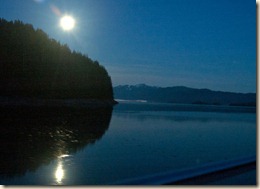 The next day, August 12, after adding 200 gallons of fuel to serve as our reserve for the trip home (we’ll do a total refuel when back in Puget Sound), we headed out. The weather kept improving as the day wore on and by the time we pulled into Tracy Arm Cove the clouds were breaking up. We even had a lovely full moon over the mountain towards our south.
The next day, August 12, after adding 200 gallons of fuel to serve as our reserve for the trip home (we’ll do a total refuel when back in Puget Sound), we headed out. The weather kept improving as the day wore on and by the time we pulled into Tracy Arm Cove the clouds were breaking up. We even had a lovely full moon over the mountain towards our south.
The weather remained good on Saturday, August 13, as we went to Cannery Cove, although the crossing was lumpy on account of the interaction between the brisk wind and current in Stephens Passage. We launched the dinghy, set two crab pots and went on the hunt for halibut in Pybus Bay. As we made our way between a couple of islands into the main bay, that same wind and current interaction occurred again. Since we were in the dinghy and not wanting to deal with much if any chop, we beat a retreat and Marcia tried her luck in more protected waters. No luck though. Back at the boat, though, we did catch a glimpse of a brown bear sow with three offspring.
Before we left on August 14, we retrieved the crab pots placed the afternoon before and managed two keeper crabs. Since the weather forecast was for a storm the next day, we decided to try an anchorage that offered good protection, a sticky bottom for the anchor and lots of swinging room for the boat in case we needed to hunker down. As it turned out, Portage Bay on the northend of Kuprenof Island only provided the last two items.
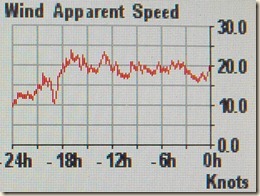 During the morning of August 15, the weather deteriorated as was forecast. The five other boats in the anchorage the night before all cleared out as the morning wore on. We stayed put assuming that while we might have some fetch bringing wave chop as was mentioned in the guide book, it wouldn’t be too bad. The wind started in the 15 to 25 knot range but picked up to 20 to 30 knots.
During the morning of August 15, the weather deteriorated as was forecast. The five other boats in the anchorage the night before all cleared out as the morning wore on. We stayed put assuming that while we might have some fetch bringing wave chop as was mentioned in the guide book, it wouldn’t be too bad. The wind started in the 15 to 25 knot range but picked up to 20 to 30 knots.
What really made it unpleasant was the current that swept past our boat depending on whether the tide was rising or falling. When the tide rose, the wind and current were fighting each other causing the wind driven waves to steepen and become closer together. Additionally, current was strong enough that it pushed the boat upwind. Our boat was the little stuffed animal being pulled (pushed in this case) apart by two children. The worse moments were when we had 3-foot choppy waves hitting the boat broadside because the current was pushing us one way while the wind was pushing us the opposite.
As the tide changed and the current with it, the battle was over and they both pulled us hard against our anchor. Fortunately the bottom was good and the anchor well set. Since everybody else had bailed that anchorage we certainly didn’t worry about swinging into anyone.
The next day, August 16, was a little bit better but not so good that we wanted to head out and fight conditions to either a new anchorage or uncertain docking in Petersburg. We stayed another night in our private purgatory.
At last, on August 17, the weather was much improved and we headed out on a rising tide (did I mention that the entrance to our anchorage was shallow with a dog-leg turn and had a propensity for fast current during tide changes?). We passed Petersburg and went straight in to Wrangell Narrows. This was our first southbound trip through the narrows and it looked different. Fortunately, we are gaining confidence and while we remain very attentive we aren’t stressed the way were on our first transit through Wrangell Narrows. We made for the very convenient anchorage in St John Harbor, just four miles south of the south entrance to Wrangell Narrows.
The next morning, August 18, we decided to do as many miles as we could since the forecast was for another storm to come through in a couple of days. The ultimate destination kept changing as we rode a favorable current out of Sumner Strait. We ended up the day at Kaguk Cove, an anchorage east of Sea Otter Sound and only 27 miles from Craig, what we intended to be our last town visited before heading into British Columbia.
With the early forecast on Friday, August 19, we knew we needed to get to Craig as quickly and as soon as we could since gale force winds were forecast that evening. Rain showers were already starting but the winds were still in the teens until we started to head into more open channels, then gusts in the upper 20’s began to buffet the boat. About the same time we picked up a radio transmission from a commercial fishing boat to the Craig Harbor Master. It sounded like everything was filled and the boats were beginning to raft up. At that point we were still 17 miles from Craig and decided to cut our losses and head back to anchorage that we knew was good. After a 20 mile trip to nowhere, we anchored again in Kaguk Cove to wait out the storm.
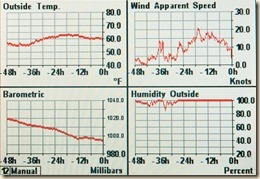 The winds picked up during the evening as forecast and continued into August 20. It rained a lot and we spent a lot of time trying to keep the interior windows from fogging up. We monitor some basic weather conditions with the instruments on the boat. What struck us was the dramatic pressure drop during the storm and the rapid temperature rise. The temperature rose during the night from the mid 50’s to the low 60’s. It felt like one of those “Pineapple Express” storms that Puget Sound gets during the winter where a tropical storm from the central Pacific comes barreling into the area.
The winds picked up during the evening as forecast and continued into August 20. It rained a lot and we spent a lot of time trying to keep the interior windows from fogging up. We monitor some basic weather conditions with the instruments on the boat. What struck us was the dramatic pressure drop during the storm and the rapid temperature rise. The temperature rose during the night from the mid 50’s to the low 60’s. It felt like one of those “Pineapple Express” storms that Puget Sound gets during the winter where a tropical storm from the central Pacific comes barreling into the area.
It was while waiting out this storm and listening to the upcoming weather that we decided that the weather pattern for Alaska had switched to a more autumnal mode and that the storms would be stronger and more frequent than seen in the summer. It was time to abandon every other goal except heading south. For us that meant heading north through (generally) more protected waters back down through Ketchikan and cross Dixon Entrance, the unavoidable open section of water separating Alaska and British Columbia, at the first weather window after positioning ourselves for the crossing.
On August 21, we motored north through El Capitan Passage out into Sumner Strait and headed for Hole-in-the-Wall on the northwest corner of Prince of Wales Island. I became enamored with the description of its entrance and protection as described in the guide book. While everything turned out fine, the entry was nerve wracking as I had to pass one submerged rock on the right then one on the left while ignoring the breaking waves from the following seas on either side of the entry. While the initial entry was as narrow, at one point further in, we concluded it was only 100’ wide. Ultimately, we had a lovely anchorage with very little wind and only a tiny bit of swell working its well through the entrance.
The next day, August 22, the exit from our anchorage was not nearly as stressful as the entry. We continued north around Point Baker, along Sumner Strait and south down Clarence Strait. The winds were forecast at 20 knots but we generally saw winds in the low teens instead. That is, until we turned the corner at Clarence Strait. At that point, winds are in the low 20’s and gusts to the upper 20’s. Since it was on the “nose”, it is more a nuisance than an issue. As we got into the more open sections of Clarence Strait, the pounding got worse but we persevered and pulled into Ratz Harbor for the night. It was a surprisingly protected and comfortable anchorage.
Once again the forecast was for gale force winds on the night of August 23. Until that time, the forecast was for SE 25 knots with 5 foot seas. We got a 0430 start in the dark (it is nearly the end of August after all!). Our goal is to tie up in Ketchikan by early afternoon. Things went well for the first 1-1/2 hours until we started into the central part of Clarence Strait. At this point we start pounding in very short duration 5 foot seas. The bow pitches up and then comes crashing down, nearly burying the anchor (8 feet above the water line) in the water. Fortunately there was a nearby bail out option and by 0815 we are tied up to the transient dock in Thorne Bay.
Later that day, we are joined on the dock by the sailing vessel Noah from Point Roberts Washington. It being the small world it is, we had gone through the Glacier Bay National Park boater orientation with them in early August. Its owners, a very nice couple, Kellie and Terry, concluded similarly to us that while, yes, the boat might be able to handle pounding like we experienced in Clarence Strait there was no reason to do it voluntarily. We spent a pleasant evening talking boats and plans.
Today, August 24, we remain at the dock planning on departing tomorrow in forecasted SE 10 knots with 2-foot seas. We will take advantage of those conditions and go as far as we can get. Hopefully we will be in Prince Rupert, BC this weekend.
Distance covered in this leg (including our “sightseeing” trip of about 20 miles) is 404.3 bringing the total distance traveled to 2585.3 nautical miles.
Better late than never. First Internet since Juneau
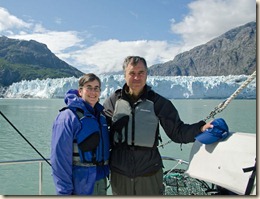
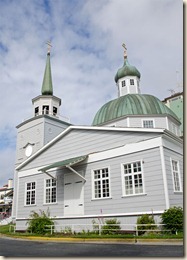 Our friends Sharon & Craig Rowley arrived from a sun-deprived Seattle to a rainy Sitka on Wednesday, July 27. After a brief orientation, we turned them loose to explore the sights around town. Marcia and I continued with a few boat chores. Since Craig is a better photographer than I am, unless otherwise noted, I am using his photographs in this blog post.
Our friends Sharon & Craig Rowley arrived from a sun-deprived Seattle to a rainy Sitka on Wednesday, July 27. After a brief orientation, we turned them loose to explore the sights around town. Marcia and I continued with a few boat chores. Since Craig is a better photographer than I am, unless otherwise noted, I am using his photographs in this blog post.
We get underway on Friday, July 29 after lunch and make the short trip to the Magoun Islands, a short distance north of Sitka. Already anchored outside the entrance to the inner cove is the Ursa Major, the boat Marcia traveled from Baja to Seattle on in 2006. We join them there since the shallow entrance channel will be at low tide the next morning when we want to depart.
We have a 6-day permit for Glacier Bay starting on August 3. The weather forecast is favorable so we elect to travel the outside coast of Chichagof Island to Icy Strait over two days. The route we take actually only has two sections on the outside. The first section of 20 miles we do on the first day and the second section of 10 miles we do on the second day.
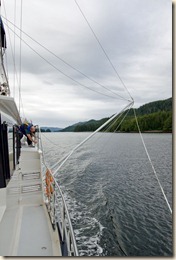 The westerly swell is not large but we drop one stabilizer on the port (weather) side into the water to reduce any rolling. Additionally, it gives us some more experience with the new stabilizers we are using this year. They are significantly lighter than our original stabilizers and are easier to retrieve from the water.
The westerly swell is not large but we drop one stabilizer on the port (weather) side into the water to reduce any rolling. Additionally, it gives us some more experience with the new stabilizers we are using this year. They are significantly lighter than our original stabilizers and are easier to retrieve from the water.
On Saturday, July 30, we pull into Kimshan Cove. The afternoon weather is nice enough that we cook hamburgers on the gas grill on the fly bridge. It isn’t nice enough to eat outside, though.
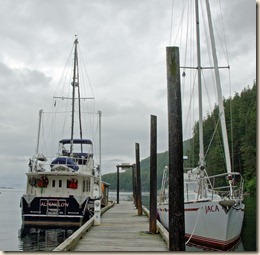 The next day, July 31, we continue the north a short ways than take the Lisianski Strait that separates Yakobi Island from Chichagof Island. We end the day on the public dock in Elfin Cove. We spent several days in Elfin Cove last year with our friends the Dorothy and Dave Nagle. A childhood friend of theirs owns Coho Bar & Grill in Elfin Cove. It had been badly damaged in a fire last year and we lent a hand at the cleanup. This year it was open for business and we had afternoon appetizers there.
The next day, July 31, we continue the north a short ways than take the Lisianski Strait that separates Yakobi Island from Chichagof Island. We end the day on the public dock in Elfin Cove. We spent several days in Elfin Cove last year with our friends the Dorothy and Dave Nagle. A childhood friend of theirs owns Coho Bar & Grill in Elfin Cove. It had been badly damaged in a fire last year and we lent a hand at the cleanup. This year it was open for business and we had afternoon appetizers there.
The clouds and rain were returning but the next day, August 1, we departed across Icy Strait for Dundas Bay. Although we timed our departure for near slack current, when we made our way through Middle Pass through the Inian Islands, the seas were sloppy on account of the swirling currents. Stellar sea lions were taking advantage of the confused waters to feed on fish that were being buffeted by the current.
We had heard many good reports about Dundas Bay but we’ll have to return in better weather. We ended up anchoring in as protected an area as we could find and watching the wind driven rain buffet us about.
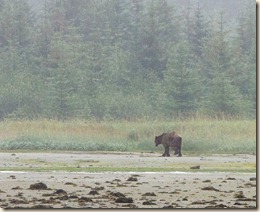 The next day, Tuesday, August 2, as we left Dundas Bay we did spot a brown (aka “grizzly”) bear foraging on the beach at low tide. We continued east along Icy Strait past the entrance to Glacier Bay (the National Park Service is adamant that you only enter on the day of your permit).
The next day, Tuesday, August 2, as we left Dundas Bay we did spot a brown (aka “grizzly”) bear foraging on the beach at low tide. We continued east along Icy Strait past the entrance to Glacier Bay (the National Park Service is adamant that you only enter on the day of your permit). 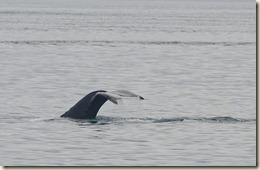 We cruised by a popular humpback whale viewing area at Point Adolphus. There were abundant number whales and gave us hope for further viewing while in the park.
We cruised by a popular humpback whale viewing area at Point Adolphus. There were abundant number whales and gave us hope for further viewing while in the park.
We anchored that night in Flynn Cove. On account of it being Marcia’s birthday, Craig did the cooking. Dessert was brownies with cookie dough ice cream.
We entered Glacier Bay on our appointed day, August 3, and attended the boater orientation at the park HQ in Bartlett Cove. There are some hiking trails near Bartlett Cove so we anchored out and dinghied to the public dock to go for afternoon hikes.
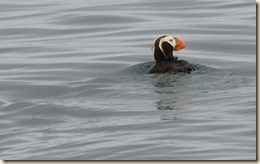 For August 4, we traveled past the bird sanctuaries of North & South Marble Island. Stellar sea lions use the haul-out rocks at one end of the island and birds nest in the steeper rock sections along the islands face. Two kinds of puffins, tufted and horned were present on the island. That night we anchored in North Sandy Cove a lovely anchorage we used in 2010 on our visit to the park.
For August 4, we traveled past the bird sanctuaries of North & South Marble Island. Stellar sea lions use the haul-out rocks at one end of the island and birds nest in the steeper rock sections along the islands face. Two kinds of puffins, tufted and horned were present on the island. That night we anchored in North Sandy Cove a lovely anchorage we used in 2010 on our visit to the park.
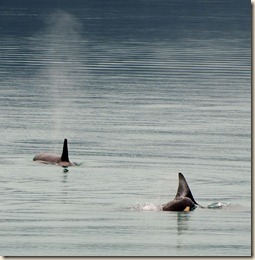 The visibility was pretty low when started our cruise the next day, August 5, up Muir Inlet. It is a long way up and we were concerned that we wouldn’t see much. Fortunately, the weather improved to give us some nice views. One unexpected treat was a pod of 4 or 5 orca whales feeding. We saw them both on the way up and the way back. After a long day of motoring along, we dropped the anchor in Blue Mouse Cove.
The visibility was pretty low when started our cruise the next day, August 5, up Muir Inlet. It is a long way up and we were concerned that we wouldn’t see much. Fortunately, the weather improved to give us some nice views. One unexpected treat was a pod of 4 or 5 orca whales feeding. We saw them both on the way up and the way back. After a long day of motoring along, we dropped the anchor in Blue Mouse Cove.
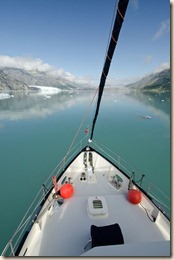 While we saw some glaciers in Muir Inlet, the iconic glacier view in Glacier Bay National Park is Margerie Glacier. Saturday, August 6, was the one day that week in which there were no cruise ships in the park. As it turned out, we had the glacier pretty much to ourselves that morning. In addition, it was the best weather we had had for several days.
While we saw some glaciers in Muir Inlet, the iconic glacier view in Glacier Bay National Park is Margerie Glacier. Saturday, August 6, was the one day that week in which there were no cruise ships in the park. As it turned out, we had the glacier pretty much to ourselves that morning. In addition, it was the best weather we had had for several days.
We made a 1/4 mile “drive-by” of the glacier front for photo-ops then moved away to a 1/2 mile and shut down the engine. There was no wind and no current so we barely moved 100 yards in the 45 minutes we drifted there. Anchorage that night was in Reid Inlet.
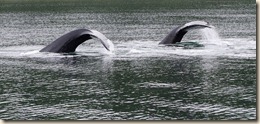 For our last night, August 7, in the park we made our way to North Finger Bay. As we were entering the bay, we saw whale spout from 3 or 4 humpback whales feeding in the bay. We put the boat in neutral and drifted 10 or so minutes while whales were feeding around us. We even had a synchronized diving show by two whales 200 yards from the boat. We waited for the whales to move away from the boat before we motored slowly towards the shallow part of the bay.
For our last night, August 7, in the park we made our way to North Finger Bay. As we were entering the bay, we saw whale spout from 3 or 4 humpback whales feeding in the bay. We put the boat in neutral and drifted 10 or so minutes while whales were feeding around us. We even had a synchronized diving show by two whales 200 yards from the boat. We waited for the whales to move away from the boat before we motored slowly towards the shallow part of the bay.
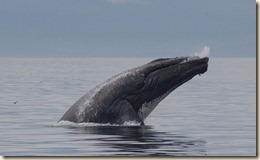 The next day, August 8, as we left the park, humpback whales gave us one last show. We saw several whales feeding and breaching a short distance from the boat. After watching them a few minutes while in neutral, we concluded the “show” was over and resumed our motoring along. Suddenly, 300 yards away, a whale breaches the water and comes crashing back. Marcia grabs the camera and races out onto the bow of the boat and waits for another breach. Not wanting to disappoint Marcia, the whale accommodates and repeats its earlier performance twice more.
The next day, August 8, as we left the park, humpback whales gave us one last show. We saw several whales feeding and breaching a short distance from the boat. After watching them a few minutes while in neutral, we concluded the “show” was over and resumed our motoring along. Suddenly, 300 yards away, a whale breaches the water and comes crashing back. Marcia grabs the camera and races out onto the bow of the boat and waits for another breach. Not wanting to disappoint Marcia, the whale accommodates and repeats its earlier performance twice more.
After the excitement, we make the journey east down Icy Strait where it joins Chatham Strait. We anchor our last night before Juneau in Funter Bay.
On the morning of August 9, before departing Craig and I retrieve the two crab pots we set the night before and find two keeper crabs. The 15 knot winds that start our journey that morning disappear as we approach Auke Bay, a few miles north of downtown Juneau, where we conclude this leg of the trip.
The distance traveled from Sitka to Juneau was 423.4 nautical miles bringing our total distance since leaving Seattle to 2181 miles.
You’d think that I could budget my time better over three days and actually get a proper blog entry describing our trip from Sitka to Juneau with our friends Sharon & Craig Rowley, but I didn’t. I’ll try to work on it while underway during the next leg.
I will upload the following pictures of some really wonderful whale experiences we had in our last 24 hours in Glacier Bay.
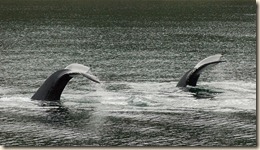 The first picture was taken after entering North Finger Bay where we anchored the night. It wasn’t until passing the entrance bar that we notice the spouts of the 3 or 4 whales feeding. We put the boat in neutral and as we drifted, the whales continued to feed, sometimes within 200 yards of the boat. After they moved away and had started another feeding dive, we slowly motored to the shallower end of the bay where we anchored for the night.
The first picture was taken after entering North Finger Bay where we anchored the night. It wasn’t until passing the entrance bar that we notice the spouts of the 3 or 4 whales feeding. We put the boat in neutral and as we drifted, the whales continued to feed, sometimes within 200 yards of the boat. After they moved away and had started another feeding dive, we slowly motored to the shallower end of the bay where we anchored for the night.
 The second picture was taken shortly before leaving the park waters by Point Gustavus. This was a lone humpback repeatedly launching itself out of the water, presumably through a very tasty herring ball.
The second picture was taken shortly before leaving the park waters by Point Gustavus. This was a lone humpback repeatedly launching itself out of the water, presumably through a very tasty herring ball.
Our plans from here are to start our return journey south to Seattle. We plan to be back in home waters the last half of September. Next major stop will probably be Petersburg.
The day after our guests, the Crowders, departed on July 18, Marcia and I also left Sitka. We didn’t go far though. Last year we thoroughly enjoyed the leisurely times we spent cruising the Ketchikan region while waiting for our buddy boat for the season, the DavidEllis, to join us. This year, we thought we’d take advantage of the time between the Crowders and our next set of guests, Sharon & Craig Rowley, to poke around Sitka.
Sitka is located on the west coast of Baranof Island. While tucked into Sitka Sound with a goodly number of islands sheltering it, if you venture west, you know you are on the coast. Fortunately, for at least the first 30 miles south from Sitka, islands continue to offer a protected route along the coast. Beyond that point, safe travel depends on having good weather conditions and being able to tuck into protected anchorages should the weather deteriorate.
On July 19, our first day of travel we covered those 30 miles south and anchored in the very sheltered Scow Bay. In some areas, you are traveling a route through submerged rocks. When you do that, you have to have confidence in the charting done by NOAA and the accuracy of your position as reported by your GPS. In those areas, we traveled along with our chart plotter set to show the results of the depth sounder. You make sure that the bottom reflects what the chart says you ought to be seeing.
One of the purposes of the cruise was for Marcia to do some serious fishing. The next day, July 20, we started slowly back north and covered the relatively short distance to Herring Bay. Marcia tried her hand at fishing for halibut from the stern of Alpenglow. She had one good bite but it got away without being hooked. The fish also got away with Marcia’s octopus bait.
We remained a second day in Herring Bay and tried fishing from the dinghy. Marcia hooked a dog fish that not only thoroughly swallowed the circle hook but also wrapped itself in the line to the point that we had to simply cut it loose. Our efforts with the prawn trap were equally unsuccessful. We cut our losses and dropped the kayaks and went paddling. The entrance to Herring Bay had several sea otters in residence so we paddled out there. The sea otters seem more bashful of our kayaks than our power boat.
On Friday, July 22 we continued north and returned to a lovely anchorage we visited last year, Samsing Cove. The cove is less than five miles from Sitka but we had it to ourselves and never would have known we were near a community except for the Alaska Air jets on approach to Sitka airport. The weather was sunny and warm (by SE Alaska standards).
The next day, July 23, we motored north across Sitka Sound and revisited the Magoun Islands Marine Park. When we were here the week before being cowards about the shallow and narrow entrance to the inner cove, we anchored outside. Having scouted the channel with the dinghy, we felt comfortable entering the very lovely inner cove.
After anchoring, we launched the dinghy and tried fishing in nearby Krestof Sound. A rock fish was the unlucky catch of the day and it served as a component of fish tacos. Our friends the Nagles and their daughter were anchored in the bay just to the east of us and dinghied over for a visit. The weather remained sunny and warm, although a change was forecasted.
We were all prepared to try more fishing on Sunday, July 24, but the weather became windy with occasional showers. We spent a leisurely day swinging at the end of our anchor chain.
The next day was calmer but definitely wetter. The wind had done a wonderful job of setting our anchor and we had to power several seconds with the chain taut in the opposite direction the anchor was set in order to pop it loose. We were back in Eliason Harbor in Sitka shortly after 10 AM.
The total distance covered during the six days was 90.1 miles, bringing our summer cruise to 1757.6 nautical miles.
We arrived in Sitka on Saturday having completed our trip from Wrangell to Sitka. Rather than a day by day journal, I’ll give a description of the highlights with photos. At the end will be a log of the anchorages and distances traveled.
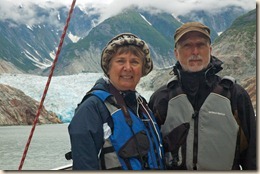 For this leg of our trip, joining us were our friends Ginny and Ken Crowder. They had never been in Alaska before so we set so goals for the trip:
For this leg of our trip, joining us were our friends Ginny and Ken Crowder. They had never been in Alaska before so we set so goals for the trip:
After the 4th of July celebrations in Wrangell, we started off towards Petersburg via Wrangell Narrows. We anchored out in Deception Cove at the south end of Wrangell Narrows in order to time the current correctly for the next day.
Before we docked in Petersburg we gave the Crowder’s another boating experience, that of boat problems. Since we passed by Petersburg at 6:30 AM, we went out into Fredrick Sound to kill some time and sight-see. As we were traveling along, we suddenly heard a very loud fan-like noise unlike anything we’ve heard before. After a minute of panic trying to figure out what it was, we identify it as the bow thruster. Flipping the breaker off solved the immediate problem. Some quick diagnosis, isolated the problem to the bow thruster control at the upper helm. As best we can figure it out, the control unit failed and sent signals to the bow thruster motor causing it to operate in a mode it ought not to. A replacement was ordered and will be picked up in Sitka.
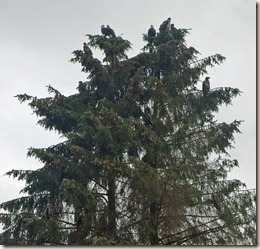 At the parking lock adjoining the docks was a tree adorned with 14 eagles. There are several seafood processing plants in Petersburg and apparently the eagles find easy pickings from the seafood waste released.
At the parking lock adjoining the docks was a tree adorned with 14 eagles. There are several seafood processing plants in Petersburg and apparently the eagles find easy pickings from the seafood waste released.
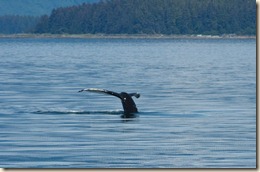 For whales, in the area just north of Cape Fanshaw, we were fortunate to watch for over a half-hour two humpback whales feeding nearby. They dived repeatedly and resurfaced five minutes later only a few hundred yards from where they went under.
For whales, in the area just north of Cape Fanshaw, we were fortunate to watch for over a half-hour two humpback whales feeding nearby. They dived repeatedly and resurfaced five minutes later only a few hundred yards from where they went under.
Humpback whales remained common occurrences the rest of the trip and we even added porpoises surfacing our bow wake and a pod of orca whales to the cetacean list.
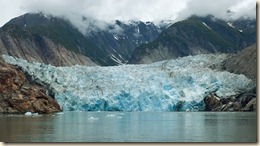 For ice, we headed into Tracy Arm where the tide water Sawyer Glaciers pumps ice into the water. The South Sawyer Glacier where we visited last year was too choked with ice to get to but the area in front of the North Sawyer Glacier was nearly wide open.
For ice, we headed into Tracy Arm where the tide water Sawyer Glaciers pumps ice into the water. The South Sawyer Glacier where we visited last year was too choked with ice to get to but the area in front of the North Sawyer Glacier was nearly wide open.
 Most SE Alaska tide water glaciers are receding. In the case of the North Sawyer, it is nearly 3/4 of a mile further back than the nautical charts show. It is a little disconcerting to see your charted position as being somewhere on a glacier. While bobbling in the water a 1/2 mile from the glacier (we are cowards), we did see a big chunk of the glacier fall off producing a significant swell which struck us several minutes later (photo courtesy of Ken Crowder).
Most SE Alaska tide water glaciers are receding. In the case of the North Sawyer, it is nearly 3/4 of a mile further back than the nautical charts show. It is a little disconcerting to see your charted position as being somewhere on a glacier. While bobbling in the water a 1/2 mile from the glacier (we are cowards), we did see a big chunk of the glacier fall off producing a significant swell which struck us several minutes later (photo courtesy of Ken Crowder).
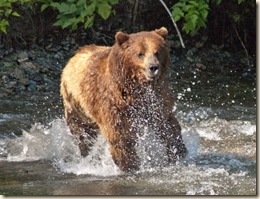 After Tracy Arm, we headed towards the Pack Creek Bear Viewing Area near Windfall Harbor in the Seymour Canal. Last year we went to the Anan Wildlife Viewing Area. The two have different feels. Anan is very intimate because the viewing platform is only 50 yards or so directly above a plunging stream. At Pack Creek, you are more distant and the surroundings are more open.
After Tracy Arm, we headed towards the Pack Creek Bear Viewing Area near Windfall Harbor in the Seymour Canal. Last year we went to the Anan Wildlife Viewing Area. The two have different feels. Anan is very intimate because the viewing platform is only 50 yards or so directly above a plunging stream. At Pack Creek, you are more distant and the surroundings are more open. 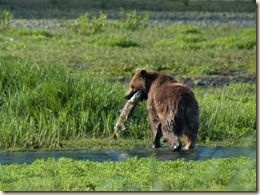 Both are worth the trip.
Both are worth the trip.
 From Pack Creek we headed towards Sitka via Peril Strait, enjoying several quiet anchorages along the way.
From Pack Creek we headed towards Sitka via Peril Strait, enjoying several quiet anchorages along the way.
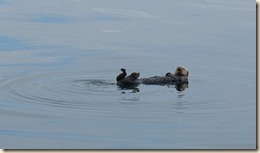 On the last day of the cruise, instead of going directly from our anchorage in the Magoun Islands to Sitka, we threw in a loop out into Sitka Sound around St Lazaria Island, a protected island for sea birds. On the way back in, we got the last item on the to punch list of things to see, sea otters.
On the last day of the cruise, instead of going directly from our anchorage in the Magoun Islands to Sitka, we threw in a loop out into Sitka Sound around St Lazaria Island, a protected island for sea birds. On the way back in, we got the last item on the to punch list of things to see, sea otters.
| Date | Destination | Distance | |
| 7/5/2011 | Deception Cove | 22.5 | |
| 7/6/2011 | Petersburg | 44.9 | |
| 7/7/2011 | Sandborn Canal | 55.0 | |
| 7/8/2011 | Tracy Arm Cove | 38.9 | |
| 7/9/2011 | Tracy Arm Cove | 49.5 | |
| 7/10/2011 | Windfall Harbor | 43.6 | |
| 7/11/2011 | Windfall Harbor | 0.0 | |
| 7/12/2011 | Henry’s Arm – Pybus Bay | 49.8 | |
| 7/13/2011 | Ell Cove | 45.0 | |
| 7/14/2011 | Appleton Cove | 31.4 | |
| 7/15/2011 | Magoun Islands | 39.0 | |
| 7/16/2011 | Sitka | 30.4 | |
| Total miles (nm) traveled this leg | 450.0 | ||
| Total miles (nm) traveled to date | 1667.5 |
At the Seattle Boat Show some of the smaller Alaska communities send representatives from their ports to encourage recreational boaters to visit. While talking with the Wrangell Harbor master, she claimed that Wrangell had the best 4th of July celebration in SE Alaska.
After spending the extended holiday weekend in Wrangell, we can’t say their the best since we haven’t seen other towns but Wrangell sets a pretty high bar for the others. If they can work on the weather, they’d be hard to beat. Here is a collection of photos from the events we saw.
Our friends, Ginny & Ken Crowder, flew in from Seattle the morning of the 4th and experienced a true small-town Alaska celebration.
From Wrangell, we head north through Wrangell Narrows, spend a night in Petersburg, and work our way to Sitka where the Crowders will fly back home.
Our first set of guests are arriving in Wrangell on July 4. We want to be in Wrangell on July 1 to get the boat cleaned and to enjoy the holiday celebrations (the Harbor Master advised us that Wrangell takes its Independence Day holiday pretty seriously). We used the days before our return to Wrangell to explore areas we passed through quickly last year en route to Juneau.
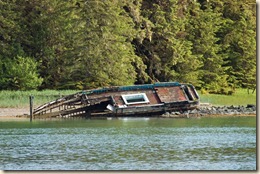 On June 21, we left Wrangell after lunch to travel a short distance to St John Harbor on the north end of Zarembo Island. The route from here goes through the Wrangell Narrows, a sometimes busy, narrow and shallow channel to Petersburg. A slow boat like ours ought to time its transit near slack, as well. We could have done it that evening and spent the night in Petersburg but we elected to do it the next morning and spend the night at anchor in St John Harbor. We did get to stare regularly at a derelict hull washed up on the shore. We don’t know its history.
On June 21, we left Wrangell after lunch to travel a short distance to St John Harbor on the north end of Zarembo Island. The route from here goes through the Wrangell Narrows, a sometimes busy, narrow and shallow channel to Petersburg. A slow boat like ours ought to time its transit near slack, as well. We could have done it that evening and spent the night in Petersburg but we elected to do it the next morning and spend the night at anchor in St John Harbor. We did get to stare regularly at a derelict hull washed up on the shore. We don’t know its history.
The day’s mileage was 20.8 with the cumulative total at 920.9. The anchor site was here.
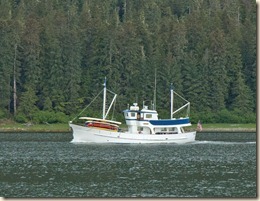 June 22 was an oh-dark thirty start to hit Wrangell Narrows as we planned. The trip through was a bit easier than last year because the visibility was better and the current was less. We continued past Petersburg and aimed for Thomas Bay. A few miles north of Petersburg we were hailed on the radio by Josh, the captain of Ursa Major. Marcia spent about seven weeks on Ursa Major in early 2006 crewing a transit from Baja to Seattle. Ursa Major is a 65-foot wood trawler that takes guests on tours in Alaska and Baja. We crossed paths with Ursa Major about four times last year.
June 22 was an oh-dark thirty start to hit Wrangell Narrows as we planned. The trip through was a bit easier than last year because the visibility was better and the current was less. We continued past Petersburg and aimed for Thomas Bay. A few miles north of Petersburg we were hailed on the radio by Josh, the captain of Ursa Major. Marcia spent about seven weeks on Ursa Major in early 2006 crewing a transit from Baja to Seattle. Ursa Major is a 65-foot wood trawler that takes guests on tours in Alaska and Baja. We crossed paths with Ursa Major about four times last year.
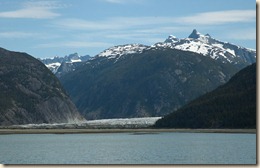 At the northeast end of Thomas Bay the Baird Glacier has receded back from the water’s edge but still is visible. The aptly named inlet called Scenery Cove is a short distance from there. Unfortunately, the depths here were a bit deeper than we like so we continued to the south end of the bay and anchored in the cove at the SE corner of Ruth Island.
At the northeast end of Thomas Bay the Baird Glacier has receded back from the water’s edge but still is visible. The aptly named inlet called Scenery Cove is a short distance from there. Unfortunately, the depths here were a bit deeper than we like so we continued to the south end of the bay and anchored in the cove at the SE corner of Ruth Island.
The sun was bright and the boat warmed up nicely. I took a nap in the afternoon (on account of the early start, of course) while Marcia did her fish gear fussin’. We did not bother with our crab pots because commercial crabbers had amply covered the area with their pots.
Distance traveled today was 52.6 bringing the total to 973.5. We anchored here.
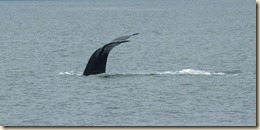 On June 23 we continued our voyage up the east shore of Frederick Sound and rounded Cape Fanshaw. While we saw a few humpback whales in the distance, we didn’t get show that we did last year with a pod of whales actively feeding relatively near.
On June 23 we continued our voyage up the east shore of Frederick Sound and rounded Cape Fanshaw. While we saw a few humpback whales in the distance, we didn’t get show that we did last year with a pod of whales actively feeding relatively near.
Wanting to explore areas we hadn’t been, we headed east into Port Houghton just north of Cape Fanshaw and anchored in Sanborn Canal. While the Douglass “Exploring SE Alaska” describes this area as seldom visited it speaks well of it. 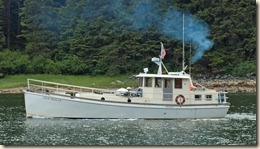 We shared the anchorage with three other boats.
We shared the anchorage with three other boats.
One of the boats had a styling similar to the classic George Buehler Diesel Duck with which our boat shares a heritage. As it turns out, we saw Gray Pelican in 2007 on the extended cruise we did that summer on our previous boat.
The rain began to fall shortly after we arrived and continued steadily through the night.
We traveled 54.0 miles bringing us to 1027.5 total nautical miles since leaving Seattle. Our anchor site was here.
The next morning, June 24, the rains became less steady and more “occasional.” We crossed Stephens Passage towards Gambier Bay. We saw more whale activity but nothing very close. Based on the positions where we observed the whales diving, they were feeding at the upwellings associated with underwater terrain changes.
The entrance to Gambier Bay is very scenic, the route working its way through many islands. The bay itself is quite large and Snug Cove, our anchorage, was hardly what I would call snug. It could easily hold a dozen boats at good anchoring depths and ample swinging room.
The trip was 30.3 miles, increasing the total miles to 1057.8. We anchored here.
Having been on the move steadily the last several days, on June 25 we took a rest day. We dropped two crab pots amongst the commercial pots also scattered throughout the cove, our prawn trap and went fishing. Of all those activities, only the fishing was productive. Marcia pulled in a 25 inch halibut (weight undetermined). After cleaning, Marcia got three 2-person portions from it. One went into the freezer and the other two were retained for consumption in the next couple of days.
We motored the next day, June 26, southwest towards Pybus Bay. We to the scenic route between the Brother Islands and inspected, from the outside, the anchorage on the west side of the West Brother. Josh on the Ursa Major speaks highly of it but the charts are poor and rocks are around so we wanted to eye-ball it before trying it sometime in the future.
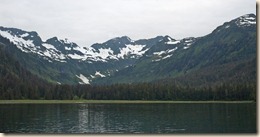 We continued on to Cannery Cove in Pybus Bay. A fishing resort is at the entrance to the cove but the anchoring site is a mile or more further in. Later we were joined by two other vessels. But were bigger than we were so they stayed further out.
We continued on to Cannery Cove in Pybus Bay. A fishing resort is at the entrance to the cove but the anchoring site is a mile or more further in. Later we were joined by two other vessels. But were bigger than we were so they stayed further out.
The cove is quite scenic with a large mountain cirque rising above a meadow. During our time there, we saw bears twice. The first time was a sow with two adolescents. Since Cannery Cove is on Admiralty Island, the bears were brown bears (aka grizzly) since those are the only type of bears on the island. Later we saw it a solo bear. Based on its color (it was darker), it was a different bear than seen earlier.
We covered 32.8 miles (a total of 1090.6) to get here.
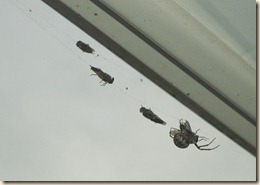 We remained at anchor June 27 to again try our hand at catching local seafood. In a reversal of our experience in Snug Cove, the crab traps gave us one nice keeper crab, the prawn trap gave us 16 prawns (8 spot and 8 striped) but fishing drew a blank.
We remained at anchor June 27 to again try our hand at catching local seafood. In a reversal of our experience in Snug Cove, the crab traps gave us one nice keeper crab, the prawn trap gave us 16 prawns (8 spot and 8 striped) but fishing drew a blank.
While we were harvesting local seafood, another “crew member” was harvesting horse flies. We aren’t sure where we picked up our spiders, but after their display of ridding us of flying pests we are glad they came aboard.
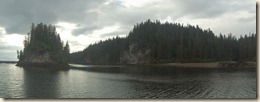 The next day, June 28, we departed across Frederick Sound to another area we hadn’t visited. We tucked into a lovely anchorage called Honeydew Cove on Kuiu Island. This certainly met my definition of a cove as you’d be hard pressed to put more than two boats in here.
The next day, June 28, we departed across Frederick Sound to another area we hadn’t visited. We tucked into a lovely anchorage called Honeydew Cove on Kuiu Island. This certainly met my definition of a cove as you’d be hard pressed to put more than two boats in here.
While we didn’t visit the beach, it looked lovely and inviting for a later trip. A rock cliff at the end of the beach even had a stone arch to add to the ambiance. The only draw back, which we were not to discover until the next day, was huge amounts of kelp on the bottom. Fortunately our anchor apparently penetrated it as when we tested the anchor before shutting down the engine, it was fine.
The day’s journey was 25.7 miles for a total of 1116.3. We anchored here.
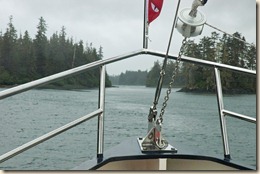 When we hoisted the anchor on June 29, we had extra 8-10 minutes to clear the kelp from the anchor and chain. When the anchor cleared the water, you couldn’t see the anchor through all of the kelp draped over it. Raking the kelp off with the boat hook eventually cleared most of it off.
When we hoisted the anchor on June 29, we had extra 8-10 minutes to clear the kelp from the anchor and chain. When the anchor cleared the water, you couldn’t see the anchor through all of the kelp draped over it. Raking the kelp off with the boat hook eventually cleared most of it off.
Keeping with the spirit of exploration on this loop, rather than returning to Petersburg and the Wrangell Narrows, we used Rocky Pass to go from Frederick Sound to Stephens Passage. We read the various guides, reviewed blogs and accounts posted on the Internet and studied the charts ahead of time. We timed our transit to hit a key section, Devils Elbow, at high slack (i.e., high tide before the water begins to ebb out).
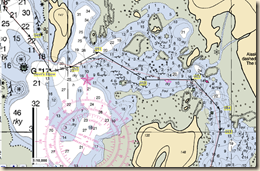 The chart clip to the left shows the tight turns through the navigation markers. The circles around the route waypoints are 100 yards in radius (200 yard diameter). The numbers on the chart show the zero tide depths in feet not fathoms (6-feet). Since we draw nearly 6 feet, at zero tide we’d only have 3 or so feet under the keel. Fortunately, we had an extra 12 or so feet on account of it being high tide but seeing only 16 feet on the depth sounder does give you pause. The route is well charted so using electronic aids made the route feasible for us.
The chart clip to the left shows the tight turns through the navigation markers. The circles around the route waypoints are 100 yards in radius (200 yard diameter). The numbers on the chart show the zero tide depths in feet not fathoms (6-feet). Since we draw nearly 6 feet, at zero tide we’d only have 3 or so feet under the keel. Fortunately, we had an extra 12 or so feet on account of it being high tide but seeing only 16 feet on the depth sounder does give you pause. The route is well charted so using electronic aids made the route feasible for us.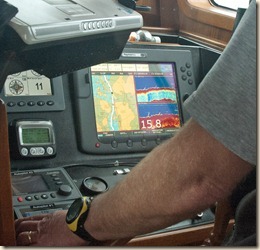
As we exited Rocky Pass, the wind increased to the 20-25 knots on our nose. While not uncomfortable, pounding our way through head seas to our anchorage in La Bourchere Bay on Prince of Wales Island was tiring. Our distance for the day was 51.2 miles bringing the total distance to 1167.5. Our anchor site was here.
After listening to the weather radio on June 30, we expected another bouncy ride but they never showed up, although we did have some heavy rain showers. We could have made it to Wrangell but we elected to anchor again at St John Harbor on Zarembo Island. We want to find space on the Reliance Dock in Wrangell and it fills up more in the afternoon. We figured a mid-day arrival would give us a better chance.
Distance traveled was 29.1 miles, a total of 1196.6. The anchor site was here, less than two boat lengths from our June 21 anchorage.
The wind was blowing pretty briskly as pulled anchor on July 1 and made our way to Wrangell. Fortunately, we got on to the Reliance Dock during a lull as the direction of the wind was blowing us off. We covered 20.9 miles, a total of 1217.5. Our position on the dock is here.
During the eleven days of our Fredericks Sound loop, we covered 317.4 miles while putting on 53.3 engine hours.